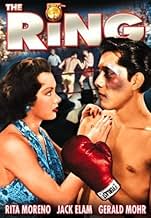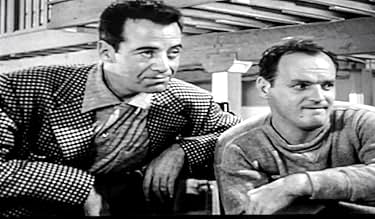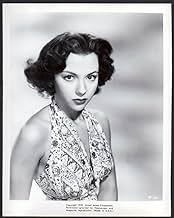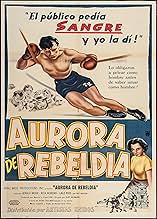अपनी भाषा में प्लॉट जोड़ेंA young American of Mexican decent in East Los Angeles, California uses the boxing ring to make a better life for himself and his family, and learns as much about being a Latino in a white s... सभी पढ़ेंA young American of Mexican decent in East Los Angeles, California uses the boxing ring to make a better life for himself and his family, and learns as much about being a Latino in a white society as he does about boxing.A young American of Mexican decent in East Los Angeles, California uses the boxing ring to make a better life for himself and his family, and learns as much about being a Latino in a white society as he does about boxing.
फ़ीचर्ड समीक्षाएं
Writer Irving Shulman was a talented screenwriter and novelist (including the classic "The Amboy Dukes"), and this is an adequate if cliched boxing story of his. Lead actor Lalo Rios is weak as a young Mexican-American in Los Angeles who learns the hard way that boxing is not such an attractive ticket to the American dream, but Rita as his girlfriend steals the show.
Sure, her part is underwritten, but what beauty from an iconic talent still going strong 72 years later! Director Kurt Neumann does a workmanlike job, obviously not on the level of his sci-fi and fantasy classics like "Kronos", "The Fly" and "She Devil".
Sticking out here is a memorable early scene where Rita takes our hero out to a movie but they're turned away at the box office, pointing to the sign that lists "Colored Night" and "Mexican Night" for segregation -it's not their night!
Sure, her part is underwritten, but what beauty from an iconic talent still going strong 72 years later! Director Kurt Neumann does a workmanlike job, obviously not on the level of his sci-fi and fantasy classics like "Kronos", "The Fly" and "She Devil".
Sticking out here is a memorable early scene where Rita takes our hero out to a movie but they're turned away at the box office, pointing to the sign that lists "Colored Night" and "Mexican Night" for segregation -it's not their night!
"This is Los Angeles: sprawling metropolis of the west. It's a beautiful city. It walks like a young giant from the mountains down to the sea. It has shiny buildings and modern freeways. Almost engulfed by the city surrounding it lies a little street "Olvera street." A street that appears to be forgotten by time."
Thus starts the movie with tourists taking pictures of "the lazy Mexicans."
A Mexican family falls on hard times when the father is laid off. Bad timing, it turns out. The family had just bought new furniture and are very proud of the blue sofa and matching chairs (the film is b&w so the chairs look grey to us). "Send it back!" demands the father. The son says he will get a job to help pay for the furniture but the father says "you are only a boy." Storming out of the house the son goes to "the clubhouse" to see his friends. Harassed by bigoted white police and denied service by white owned businesses "Tommy" lets his rage out and gets in a fight.
Tommy is seen fighting by a talent scout - one who is interested in making Tommy a professional fighter. "Don't you want to be something? Do you want to be pushed around like your dad?" Tommy is convinced and "Tommy Kansas" is born.
Tommy's father thinks it's a disgrace. "I am a poor man, but I am not a brute!" But the rest of the family is behind him. "If you do not give up fighting you will leave this house!" exclaims his father as he storms off.
I will admit to not being a big boxing fan. This film, however, kept my interest. The main character "Tommy" is well played and his transformation from naive street kid to young seasoned boxer makes this film worthwhile.
Thus starts the movie with tourists taking pictures of "the lazy Mexicans."
A Mexican family falls on hard times when the father is laid off. Bad timing, it turns out. The family had just bought new furniture and are very proud of the blue sofa and matching chairs (the film is b&w so the chairs look grey to us). "Send it back!" demands the father. The son says he will get a job to help pay for the furniture but the father says "you are only a boy." Storming out of the house the son goes to "the clubhouse" to see his friends. Harassed by bigoted white police and denied service by white owned businesses "Tommy" lets his rage out and gets in a fight.
Tommy is seen fighting by a talent scout - one who is interested in making Tommy a professional fighter. "Don't you want to be something? Do you want to be pushed around like your dad?" Tommy is convinced and "Tommy Kansas" is born.
Tommy's father thinks it's a disgrace. "I am a poor man, but I am not a brute!" But the rest of the family is behind him. "If you do not give up fighting you will leave this house!" exclaims his father as he storms off.
I will admit to not being a big boxing fan. This film, however, kept my interest. The main character "Tommy" is well played and his transformation from naive street kid to young seasoned boxer makes this film worthwhile.
Even the cheap production values of The Ring which admittedly looks like it was shot on chump change give it a look of authenticity. The Ring is a fine film about a young Mexican-American kid who thinks that boxing could be his ticket out of the slums. The lead here is played by young Lalos Rios who went on to a substantial career for the next twenty years.
Better known of course is Rita Moreno who was doing her fourth film and she plays Rios's girl friend. It's a part light years different from Anita in West Side Story.
Lalos Rios plays young Tommy Cantanios whose family is going through a real financial crisis. His father is laid off from work and they owe a lot of money for furniture on credit. Young Tommy asks to help, but his father, Martin Garralaga sluffs off the offer.
In the history of Mexican-Americans, The Ring tells its story in a time almost halfway between the zoot suit rioters of the Forties and the organization of migrant farm laborers by Cesar Chavez in the Sixties. Still a time when the discrimination that brought on the zoot suit riots was very real.
After a couple of encounters with some discrimination young Rios gets a lift by chance from fight manager Gerald Mohr who sees some possibilities in the kid. He takes him under his wing and changes his professionally to Tommy Kansas. He and trainer Robert Osterloh bring him up the ranks slowly.
Of course Rios is impatient and Mohr starts to question whether he really does have the talent to make it really big in the fight game.
The Ring is a very realistic film about the fight game and life in East Los Angeles in the Fifties. Look also for good performances from Jack Elam as a sleazy fight promoter and from Art Aragon who was a popular welterweight boxer from back in the day who later went into acting after his ring days were done.
Rios learns two very valuable lessons, one is best summed up by that eminent American philosopher Clint Eastwood who once remarked a man's got to know his limitations. But even more important Rios learns that The Ring is not the only place he can fight for his beliefs and his people. The arena of life is not just a squared circle.
Better known of course is Rita Moreno who was doing her fourth film and she plays Rios's girl friend. It's a part light years different from Anita in West Side Story.
Lalos Rios plays young Tommy Cantanios whose family is going through a real financial crisis. His father is laid off from work and they owe a lot of money for furniture on credit. Young Tommy asks to help, but his father, Martin Garralaga sluffs off the offer.
In the history of Mexican-Americans, The Ring tells its story in a time almost halfway between the zoot suit rioters of the Forties and the organization of migrant farm laborers by Cesar Chavez in the Sixties. Still a time when the discrimination that brought on the zoot suit riots was very real.
After a couple of encounters with some discrimination young Rios gets a lift by chance from fight manager Gerald Mohr who sees some possibilities in the kid. He takes him under his wing and changes his professionally to Tommy Kansas. He and trainer Robert Osterloh bring him up the ranks slowly.
Of course Rios is impatient and Mohr starts to question whether he really does have the talent to make it really big in the fight game.
The Ring is a very realistic film about the fight game and life in East Los Angeles in the Fifties. Look also for good performances from Jack Elam as a sleazy fight promoter and from Art Aragon who was a popular welterweight boxer from back in the day who later went into acting after his ring days were done.
Rios learns two very valuable lessons, one is best summed up by that eminent American philosopher Clint Eastwood who once remarked a man's got to know his limitations. But even more important Rios learns that The Ring is not the only place he can fight for his beliefs and his people. The arena of life is not just a squared circle.
This film was presented on TCM during Hispanic Heritage month as a companion piece to "The Lawless". Both works deal with anti Mexican- American prejudice in California in the 50s and feature the work of one of the few non stereotyped Latinx actors in Hollywood at the time, Lalo Rios. And while "The Lawless" is the more famous and heralded of the two, with a bigger budget and a more artistically significant director, I preferred this unabashed B movie about a Los Angeles barrio kid trying to box his way out, with its low budget, crude immediacy, to Joseph Losey's more polished work that mostly focuses on the effect of racism on Anglo liberals.
Are there flaws? You betcha. As in most inexpensive, indie type movies the acting can be problematical. It is especially shocking to see Rita Moreno as a typical ingenue with a very limited emotional range. Obviously Kurt Neumann was not the director to see and extract her future talent. Rios is considerably better although he will never be confused with Robert Ryan in "The Set Up" or even Mickey Rooney in "Killer McCoy", for that matter, to take just two other 50s boxing flics. I also noticed a tendency, in Irving Shulman's screenplay from his novel, for the dialogue to be more stiff and declamatory when the Mexican American characters are speaking to each other than when the Anglos are conversing. Can't say I liked this tendency very much.
Making up for the above lapses, however, are well staged fight scenes as well as tense, powerful examples of discrimination directed by the white denizens of LA toward the brown skinned. The scene set in the Beverly Hills coffee/soda shop, for me at least, had much more of an impact than any number of riots and attempted lynchings, a-la "Lawless".
Bottom line: As is often the case in Tinseltown the B picture is mightier than the A. Give it a B plus.
Are there flaws? You betcha. As in most inexpensive, indie type movies the acting can be problematical. It is especially shocking to see Rita Moreno as a typical ingenue with a very limited emotional range. Obviously Kurt Neumann was not the director to see and extract her future talent. Rios is considerably better although he will never be confused with Robert Ryan in "The Set Up" or even Mickey Rooney in "Killer McCoy", for that matter, to take just two other 50s boxing flics. I also noticed a tendency, in Irving Shulman's screenplay from his novel, for the dialogue to be more stiff and declamatory when the Mexican American characters are speaking to each other than when the Anglos are conversing. Can't say I liked this tendency very much.
Making up for the above lapses, however, are well staged fight scenes as well as tense, powerful examples of discrimination directed by the white denizens of LA toward the brown skinned. The scene set in the Beverly Hills coffee/soda shop, for me at least, had much more of an impact than any number of riots and attempted lynchings, a-la "Lawless".
Bottom line: As is often the case in Tinseltown the B picture is mightier than the A. Give it a B plus.
Outstanding overlooked boxing film with an outstanding cast of B actors. Lalo Rios stands out and it seems his fictional boxing career mirrored his real life acting career, in that he showed alot of potential, but for some unexplained reason, never became successful. Filmed on location in early 1950s California in glorious black and white. Very realistic and unromantizied look at boxing and ethnic discrimination. Honestly, I think this film is better then Raging Bull.
क्या आपको पता है
- ट्रिवियाRobert Altuna received an "Introducing" credit.
- गूफ़Before the final boxing match; real film footage of Art Aragon is clipped into the fight. His three corner men in the real footage are clearly completely different from the actors playing his corner men in the movie.
- कनेक्शनReferenced in Crisis in Morality (1962)
टॉप पसंद
रेटिंग देने के लिए साइन-इन करें और वैयक्तिकृत सुझावों के लिए वॉचलिस्ट करें
विवरण
- रिलीज़ की तारीख़
- कंट्री ऑफ़ ओरिजिन
- भाषाएं
- इस रूप में भी जाना जाता है
- Pachuco
- फ़िल्माने की जगहें
- उत्पादन कंपनी
- IMDbPro पर और कंपनी क्रेडिट देखें
- चलने की अवधि1 घंटा 19 मिनट
- रंग
- पक्ष अनुपात
- 1.37 : 1
इस पेज में योगदान दें
किसी बदलाव का सुझाव दें या अनुपलब्ध कॉन्टेंट जोड़ें



























